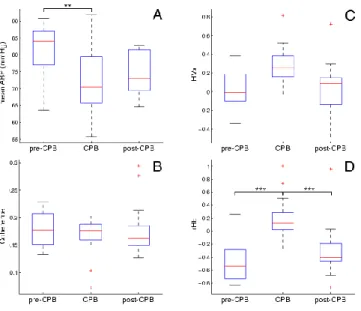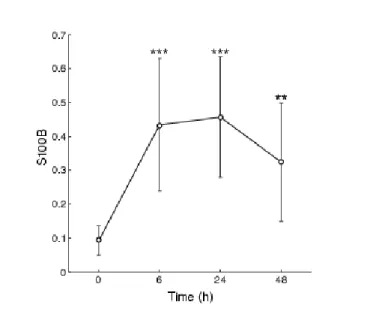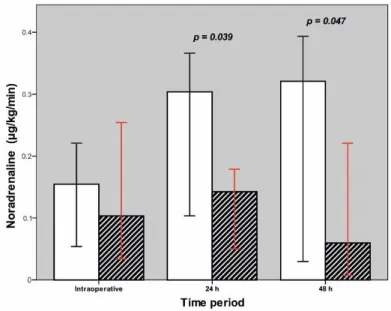Link between normotensive cardiopulmonary bypass and postoperative organ dysfunctions in high risk patient groups
Ph.D. Doctoral Thesis
Endre Németh Semmelweis University Doctoral School of Clinical Medicine
Supervisor: János Gál, M.D., Ph.D.
Official reviewers: Katalin Keltai, M.D., Ph.D.
Gábor Nardai, M.D., Ph.D.
Head of Examination Board: László Entz, M.D., Ph.D.
Members of Examination Board: Endre Zima, M.D., Ph.D.
László Székely, M.D., Ph.D.
Budapest 2018
2 INTRODUCTION
Owing to the major advances in the surgical technique, cardioprotection, mechanical circulatory support and perioperative anaesthesia and critical care achieved over the last 50 years the cardiac surgery has become a reasonable therapeutic option for high risk patients with cardiac diseases resulting in their growing proportion within the cardiac surgical patient population. Interestingly, while the operative mortality shows a continuous decline (1-3%), the frequency of postoperative organ dysfunctions related to cardiac surgery (20-80% depending on the type of dysfunction) remains constant influencing the long term mortality and quality of life after cardiac surgery.
The postoperative organ dysfunctions are typically linked to special events induced by cardiopulmonary bypass (CPB), which can be characterized by haemodynamic alterations, inflammatory response and ischaemia / reperfusion injury. Nevertheless, it can be presumed that the dominance of each pathological event might differ in the development of an organ dysfunction depends on the patient’s characteristics, preoperative organ functions, presence of immune priming, reserves of homeostatic compensatory mechanisms and the complexity of cardiac surgery. In fact, the predominating process determines interventions of that contribute to prevent or mitigate the postoperative organ dysfunctions associated to CPB-surgery.
Two important groups of cardiac surgical patients should be highlighted in terms of chronically decreased reserve of organ functions and
3
homeostatic compensatory mechanisms, who are obviously at the highest risk for developing postoperative organ dysfunction after cardiac surgery.
They are the aging patients and patients with chronic heart failure.
In our investigations we have focused on the explorative analysis of the pathogeneses of common postoperative organ dysfunctions of high risk cardiac surgical patients such as the neurological dysfunction/cognitive decline (POCD; 25-80%) in the elderly receiving elective normotensive CPB surgery and the circulatory dysfunction/vasoplegia syndrome (VS;
35-45%) in end-stage heart failure patients undergoing orthotopic heart transplantation.
AIMS
The aims of our investigations were to explore (A) the alteration of the regional cerebral haemodynamics of elderly patients during normotensive CPB surgery using dynamic near-infrared spectroscopy (NIRS) parameters and their link with S100B biomarker; (B) the association between the magnitude of post-CPB inflammatory response defined by the postoperative procalcitonin kinetics and the frequency of POCD in elderly; (C) the modifying effects of intraoperative cytokine haemoadsorption (HA) on the frequency and severity of postoperative vasoplegia syndrome after orthotopic heart transplantation (HTx).
4 METHODS
Subjects
We recruited patients with the age criteria of ≥ 45 years old (study I.) and
≥ 60 years old (study II.) who were scheduled for elective CPB surgery.
We have also enrolled age-matched subjects from primary care practice who had no surgery or hospitalization in the last 12 months to create normative control group (study II.). Finally, end-stage heart failure patients (≥ 18 years old) were included into study III who underwent HTx.
NIRS measurements and post-hoc data analysis
Intraoperative NIRS measurements were performed using a continuous wave NIRS-LEDI imager, a 3 wavelength (730, 805 and 3 850 nm), 16 channel research instrument. NIRS signals were registered during the entire operation at a sampling rate of 3 Hz. The raw 16 channel NIRS data were resampled and screened with continuous wavelet transform algorithm and band pass filtered between 0.02-0.4 Hz.
Computing cerebral regional compartmental cross correlation coefficient (rHb(t)) and haemoglobin volume index (HVx(t))
rHb(t) was computed by running Pearson correlation of oxyhaemoglobin (HbO) and deoxyhaemoglobin (HbR) time series and HVx(t) was determined using running Pearson correlation between relative total haemoglobin and arterial blood pressure time series. Components reflecting neuronal activity-related changes (HbN) and components
5
capturing correlated hemodynamic events (HbH) were derived from the extension of model by Cui et al. rHb, HVx, HbN and HbH values were averaged in 15 minute time blocks of steady state at the three main stages of the operation: pre-CPB, on-CPB and post-CPB.
Neuropsychological assessment
The assessment of neurocognitive functions was performed on the day before surgery and the seventh postoperative day in the cardiac surgery group by the following test battery: Mini Mental State Examination; Trail Making Tests A and B; Digit Symbol Test; Stroop Colour and Word Test.
The Beck Depression Inventory and State-Trait Anxiety Inventory were used to examine mood states and anxiety levels at the same time points as the neurocognitive assessment. Subjects in the normative control group were examined and retested after a time interval of 7 days with the same test battery and protocol.
Measurement of inflammatory markers
Procalcitonin (PCT), C-reactive protein (CRP) concentrations and white blood cells count (WBC) were measured at the following six pre-specified time points: before the operation and then every 24 h during the first five postoperative days. Concentrations greater than 0.5 μg/L PCT and 5.0 mg/L CRP were considered elevated levels according to their normal values. The inflammatory response was defined as “low” for PCT ≤ 0.5 μg/L or “high” for PCT > 0.5 μg/L measured on the first postoperative day.
6 S100B measurement
We performed S100B biomarker assessments at the induction of anaesthesia and 6, 24 and 48 hours postoperatively. Concentration greater than 0.2 µg/L at 48-hour time point was taken indicating a pathological release of S100B.
Cytokine haemoadsorption treatment
Selection of HTx recipients to receive intraoperative cytokine HA treatment (CytoSorb™) was based on expert opinion. End-stage heart failure patients complicated by one or more chronic organ dysfunctions prior to heart transplantation, poor functional status with expectation of developing severe VS in the perioperative period had priority for introducing intraoperative CytoSorb™ treatment. CytoSorb™ was applied for a one-cycle treatment during CPB. The 300-mL CytoSorb™
cartridge was positioned after the oxygenator providing near maximal blood flow through the cartridge via a specified side branch of the CPB circuit.
Statistical analysis
Descriptive statistics of data were expressed as mean ± standard deviation and median (interquartile range). Categorical variables were presented as number of patients and percentage. Unpaired t-test, Mann-Whitney U test, and χ2 test or Fisher’s exact test were used for the unmatched comparisons. Paired t-test, Wilcoxon rank-sum test and McNemar test were applied for the matched comparisons where appropriate.
7
The within-subject change in the performance on neurocognitive tests was measured using the Reliable Change Index modified for practice (RCIp) involving data from the normative control group (study II.)
To improve the imbalance in patients’ baseline characteristics, we performed propensity score matching analysis (study III.).
RESULTS
Study of cerebral regional haemodynamics and oxygenation during CPB surgery
Of the enrolled 20 patients, 14 were finally analysed. The mean age was 66 ± 9 years in the cohort. The mean arterial pressure (MABP) dropped from 82.1 ± 7.7 mmHg to 72.0 ± 9.9 mmHg (p = 0,007) on-CPB (Fig. 1).
The HbN and HbH parameters did not show significant changes during the three phases of the operation. However, the normotensive CPB altered rHb(t) pattern dramatically. Mean rHb(t) was anticorrelated (-0.45 ± 0.30) pre-CPB, then transiently turned correlated on-CPB (0.20 ± 0.34, p <
0.001) and dipped again into the anticorrelated range (-0.29 ± 0.42, p = 0.003) following bypass (Fig. 1).
8
Figure 1. Descriptive statistical characterization of data for the three phases of cardiac surgery. A: arterial blood pressure (ABP), B: coherence between the spectra of ABP(t) and regional total haemoglobin content (ΔHbT(t)), C: mean haemoglobin volume index (HVx), D: mean cross-correlation coefficient of the regional haemoglobin compartments (rHb). ** p<0.01, ***
p<0.001.
Mean HVx(t) showed a correlated tendency on-CPB when compared to pre-CPB (0.06 ± 0.24 vs 0.30 ± 0.26, p = 0.056) (Fig. 1). We detected positive extreme values of mean HVx(t) ≥ 0.4 on-CPB in five patients.
Serum S100B levels were significantly elevated in 6-, 24-, and 48-hour postoperatively as compared to its baseline value (Fig. 2).
9
Figure 2. Serum levels of S100B in the postoperative period. Error bars show the 95% confidence intervals of the data. ** p<0.01, *** p<0.001.
Study of the association between POCD and inflammatory response during normotensive CPB surgery
Seventy-four elderly patients with a mean age of 68 ± 6 years were recruited in this study. The normative controls (n = 32) and patients in the cardiac surgery group (n = 42) were similar in baseline characteristics, including the age, gender and education. Based on the a priori definition, cardiac surgery patients were separated into the low inflammatory response (LIR, n = 20) and high inflammatory response (HIR, n = 22) groups. While the PCT peaked on postoperative day (POD) 1 in the HIR group, it remained within the normal range (PCT ≤ 0.5 µg/L) in the LIR
10
group throughout the postoperative period (Fig. 3). CRP reached its highest serum levels between POD2 and POD3 in both groups and did not show significant differences between the kinetics of the two groups (Fig.
3). WBC had a significantly higher peak value on POD1 in the HIR group compared to the LIR group (Fig. 3), and it showed a strong correlation with the PCT level on the POD1 in the HIR group (r = 0.67, p = 0.001).
Based on the a priori definition, 15 of 42 patients (35.7%) met the criteria of POCD. The RCIp Z scores of each neurocognitive test were similar in the two inflammatory response groups. Hence, the frequencies of POCD in the LIR group did not vary from that in the HIR group observed at the first postoperative week (7 vs 8 cases, respectively). We did not find differences between the LIR and HIR groups in the preoperative BDI scores, pre- and postoperative levels of anxiety, perioperative parameters and postoperative complications.
11
12
Figure 3. Changes in the procalcitonin (A), C-reactive protein (B) and white blood cell count (C) levels during the postoperative period. A continuous line demonstrates low inflammatory response (LIR) and a dotted line shows the high inflammatory response (HIR) group. Spots and error bars represent the medians and 95% confidence intervals. *** p<0.001.
Sudy of the intraoperative application of cytokine haemoadsorption during HTx
After seven exclusions, 84 patients were included into our observational study with a mean age of 50 ± 10 years. Intraoperative cytokine HA was used in 24 cases (28.6%). Propensity score matching from the study cohort of 60 controls and 24 cytokine HA-treated patients gave 16 matched pairs. The incidence of VS was less in the HA-treated group than in controls (20.8% vs 43.3%, p = 0.054). Median noradrenaline requirements was significantly higher in the control group compared to the HA-treated patients during the first 24 hours’ post-transplantation and on the second postoperative day (p = 0.047) (Fig. 4). Primary hemodynamic parameters did not show any differences between the control and HA-treated groups as demonstrated by the average cardiac index, MABP, systemic vascular resistance index and pulmonary vascular resistance over the first 24 hours postoperatively. Additionally, the kinetics of PCT and CRP were similar in the two groups. Details of postoperative complications are summarized in Table 1.
13
Figure 4. Comparison of noradrenaline requirements in the early postoperative period. Blank bar demonstrates control group and striped bar indicates CytoSorbTM treated patients. Data are presented as medians. Error bars show 95% confidence interval.
Table 1. Comparison of clinical outcome parameters in Propensity Score matched data.
Controls (n = 16)
HA-treated Pts (n = 16)
p
PO bleeding, mL 750 (500, 1390) 685 (560, 1290) 0.93
RO for bleeding, n 5 (31.2%) 2 (12.5%) 0.06
Transfusion/24 hours
PRBC, unit 2 (0, 10) 2 (1, 4) 0.91
FFP, unit 0 (0, 5) 1 (0, 2) 0.68
Platelet, unit 0 (0, 16) 0 (0, 12) 0.95
MV time, hour 129 (19, 386) 24 (17, 64) 0.29
MV time > 72 hours, n 5 (31.2%) 3 (18.8%) 0.10
PGF, n 4 (25%) 2 (12.5%) 0.03
14
Postoperative MCS, n 4 (25%) 2 (12.5%) 0.03
AKI, n 6 (37.5%) 2 (12.5%) 0.12
Postoperative RRT, n 4 (25%) 2 (12.5%) 0.03
Sepsis, n 5 (31.2%) 4 (25%) 0.14
Early graft rejection, nc 4 (25%) 5 (31.2%) 0.12 Length-of-ICU stay, days 20 (7, 45) 10 (9, 29) 0.89 Length-of-H stay, days 30 (20, 52) 34 (26, 58) 0.35
30-day mortality, n 2 (12.5%) 0 0.001
Data are presented as median (interquartile range) and number of patients (percent). HA= cytokine haemoadsorption; Pts= patients; PO= postoperative, RO= reoperation; PRBC= packed red blood cell; FFP= fresh frozen plasma;
MV= mechanical ventilation; PGF= primary graft failure; MCS= mechanical circulatory support; AKI= acute kidney injury; RRT= renal replacement therapy;
ICU= intensive care unit; H= hospital
15 CONCLUSIONS
1. Our results show that the normotensive CPB technique can result in on-CPB cerebral hypoperfusion in elderly patients caused by significant MABP decrease, dysfunction of cerebral vascular reactivity and a consecutive fluctuation around the lower limit of cerebral autoregulation.
2. Our data support that the on-CPB emerging haemodynamic stress can be described by the alteration of rHb(t). This stress is not critical (mild) until HbN and HbH parameters are constant.
3. Despite a mild on-CPB haemodynamic stress, it might result in blood-brain barrier damage in elderly patients as it was demonstrated indirectly by pathological concentrations of S100B biomarker at 48 hours.
We hypothesize that the on-CPB haemodynamic stress could be a predominant factor of POCD associated with normotensive CPB surgery of elderly.
4. Our results reveal that the magnitude of postoperative inflammatory response does not influence the frequency of POCD.
Furthermore, the non-infective inflammatory response presumably plays only a minor role in the pathogenesis of POCD of elderly patients.
16
5. Due to chronic organ dysfunctions and immune priming of end- stage heart failure patients the HTx procedure might be accompanied by an exaggerated inflammatory response and ischaemia / reperfusion injury.
These predominating processes can result in progressive organ failures such as VS (43.3% of control patients met the criteria of VS).
6. Our results confirm indirectly the predominant role of the perioperative proinflammatory and ischaemia / reperfusion processes in the development of postoperative organ failures and complications after HTx, because these latter ones could be mitigated by the intraoperative cytokine HA-treatment.
17 PUBLICATIONS
Publications linked to the thesis
Nemeth E, Szigeti S, Varga T, Daroczi L, Barati Z, Merkely B, Gal J.
(2018) Continuous cytokine haemoadsorption incorporated into a venoarterial ECMO circuit for the management of postcardiotomy cardiogenic and septic shock – a case report. Perfusion, 33: 593-596. IF:
1.147*
Nemeth E, Kovacs E, Racz K, Soltesz A, Szigeti S, Kiss N, Csikos G, Koritsanszky KB, Berzsenyi V, Trembickij G, Fabry S, Prohaszka Z, Merkely B, Gal J. (2018) Impact of intraoperative cytokine adsorption on outcome of patients undergoing orthotopic heart transplantation—an observational study. Clin Transplant, 32: e13211. IF: 1.518*
Nemeth E, Vig K, Racz K, Koritsanszky KB, Ronkay KI, Hamvas FP, Borbély C, Eory A, Merkely B, Gal J. (2017) Influence of the postoperative inflammatory response on cognitive decline in elderly patients undergoing on-pump cardiac surgery: A controlled, prospective observational study. BMC Anesthesiol, 17:113. IF: 1.788
18 Other publications
Pólos M, Kovács A, Németh E, Merkely B. (2018) Acute thrombosis of the ascending aorta causing right ventricular failure: first manifestation of antiphospholipid syndrome. Eur J Cardiothorac Surg, doi:
10.1093/ejcts/ezy218. (In Press) IF: 3.504*
Szudi L, Székely L, Sápi E, Prodan Z, Szolnoky J, Csomós Á, Nyolczas N, Paulovich E, Németh E, Hartyánszky I, Zima E, Sax B, Bertalan A, Hejjel L, Bogáts G, Babik B, Gombocz K, Szerafin T, Koszta G, Molnár A. (2018) Perioperative use of levosimendan in cardiac surgery:
Hungarian recommendation. Orv Hetil, 159: 870-877. IF: 0.322*
Lakatos BK, Tokodi M, Assabiny A, Tősér Z, Kosztin A, Doronina A, Rácz K, Koritsánszky KB, Berzsenyi V, Németh E, Sax B, Kovács A, Merkely B. (2018) Dominance of free wall radial motion in global right ventricular function of heart transplant recipients. Clin Transplant, 32:
e13192. IF: 1.518*
Farkas P, Csuka D, Mikes B, Sinkovits G, Réti M, Németh E, Rácz K, Madách K, Gergely M, Demeter J, Prohászka Z. (2017) Complement activation, inflammation and relative ADAMTS13 deficiency in secondary thrombotic microangiopathies. Immunobiology, 222: 119-127.
IF: 2.873
19
Szentmihályi I, Barabás JI, Bali Á, Kapus G, Tamás C, Sax B, Németh E, Pólos M, Daróczi L, Kőszegi A, Cao C, Benke K, Kovács PB, Fazekas L, Szabolcs Z, Merkely B, Hartyánszky I. (2016) Heart transplantation and long-term lvad support cost-effectiveness model. Magyar Sebészet;
69: 186-193.
Fazekas L, Sax B, Hartyánszky I, Pólos M, Horkay F, Varga T, Rácz K, Németh E, Székely A, Paulovich E, Heltai K, Zima E, Szabolcs Z, Merkely B. (2015) Mechanical circulatory support saves lives - three years' experience of the newly established assist device program at Semmelweis University. Orv Hetil, 156: 521-527. IF: 0.291
Szabolcs Z, Hartyánszky I, Hüttl T, Fazekas L, Balogh O, Becker D, Soós P, Varga T, Paulovich E, Németh E, Rácz K, Horkay F, Merkely B.
(2013) 2012 - the year of success in the 20 year-old adult heart transplant program of Hungary. Orv Hetil; 154: 863-867.
Mándli T, Fazakas J, Ther G, Árkosy M, Füle B, Németh E, Fazakas J, Hidvégi M, Tóth S. (2008) Evaluation of liver function before living donor liver transplantation and liver resection. Orv Hetil, 149: 779-786.
Fazakas J, Mándli T, Ther G, Füle B, Tóth S, Fazakas J, Németh E, Hidvégi M, Arkosy M. (2007) Liver resection for living-donor liver transplantation: anesthesia and intensive care aspects. Orv Hetil, 148:
2269-2273.
20
Fazakas J, Mándli T, Ther G, Árkossy M, Pap S, Füle B, Németh E, Tóth S, Járay J. (2006) Evaluation of Liver Function for Hepatic Resection.
Transplant Proc, 38: 798-800. IF: 0.962


